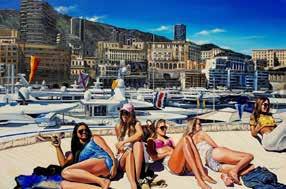COMMUNITY
Boa Esperança. Courtesy The Algarve Tourist Board
Chief mechanic António Silva and Commandant José Gravata on board the caravel.
Exploring the high seas BY LENA STRANG
Bartolomeu Dias. Scene from the Portuguese Discoveries Wax Museum.
The replica caravel Boa Esperança takes pride of place by Lagos marina. While it looks tranquil enough anchored amongst the yachts and fishing boats bobbing in the water, its 15th century predecessors were launched on perilous voyages of exploration that changed the world. Commander José Gravata has kindly invited me to visit the caravel and is more than happy to show me the ship and relay stories of past exploits. He speaks with palpable pride standing at the helm, looking the part with his bronzed, weather-beaten face and bushy beard. He is ably assisted by chief mechanic José António Silva, who has had a long career in the Portuguese navy. I’m told the Boa Esperança was built in 1990 at Vila do Conde shipyard in the north of the country. It’s an authentic replica of the ships that were used for the Portuguese explorations in the 15th century. “Naval experts used archaeological finds from caravels in Aveiro and the Tagus river, along with drawings from museum archives,” Commander José says, adding with a glint in his eye: “We have some additional creature comforts for our present voyages though!” In 2001, the Algarve Tourist Board acquired the caravel to promote the culture and history of the Algarve and its importance in the Portuguese Discoveries. As José outlines the history of the caravel, I begin to appreciate its significance in the development of seafaring. It has its origins in the earlier Portuguese
4
Follow us on tomorrowalgarve
fishing boats built in the 13th century, derived from the Moorish quarib. Keen to launch exploratory voyages in the mid 15th century, Henry the Navigator saw the potential in these nimble, manoeuvrable vessels that used triangular lateen sails capable of tacking against the wind. They were a boon to sailors who could explore the African coastline and, with their shallow keel, were also able to sail upriver. This was in contrast to the ancient heavier Mediterranean cargo vessels with one mast and a fixed square sail used at the time. The speed, economy and agility of the caravel made it the best sailing vessel of its time. “We mustn’t underestimate either the knowledge of astronomy, mathematics and technology that the Arabs brought to Europe and which was then further developed by Portuguese mariners,” José emphasises. There was limited crew and cargo space as these ships were used for exploratory purposes. Later carracks or naus were developed to cater for longer voyages with the ability to carry more provisions.















